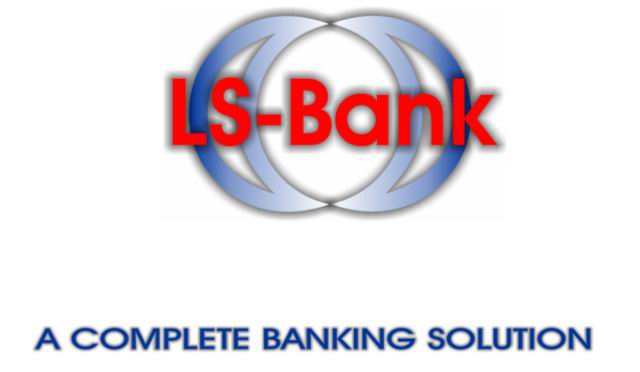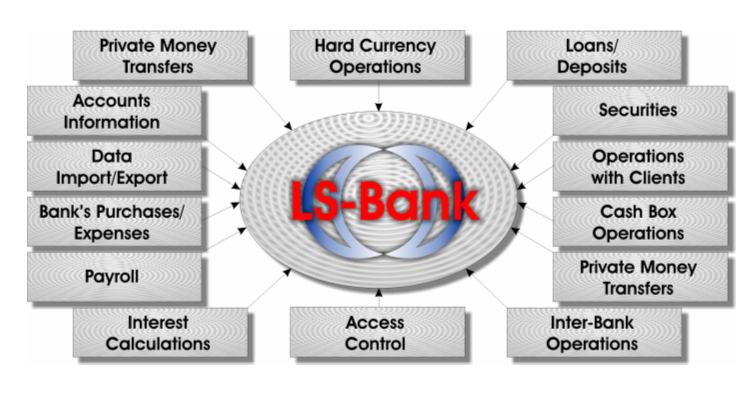
LS-Bank
is a full solution for automation of banking activities.
The
system is built around a unified accounting nucleus and supports all functions
of both the country’s Central (National) Bank and any commercial bank.
The
system operates under DBMS Oracle 8.1 and Windows NT platform. The front-end
applications are implemented with Borland C++ and Oracle PL/SQL.
LS-Bank supports user interface
and data entry in three languages (depending on a particular user’s
preference): English, Armenian and Russian.
The user interface language is chosen by the user at the setup phase, whereas
the data entry language may differ from one entry form to the other.
LS-Bank
has extended access control features. The
access control system has definitions of user, user role and user group. A user
may have several roles and belong to several user groups. The rights of a
particular user are defined by unification of the rights of his/her roles and
participated user groups. Each user or a user group has access to only those
objects and functions, which are allowed by the Security Service. Each entry
form, window, page, menu item, button, account, client, report, record owner
(each record in the database has its owner – creator or master), etc. are
considered as a separate object for access. This allows configuration of the
system according to the tasks of a particular user.
Any
change in the database
is logged
on the level of triggers with registration of the user who did the change and
the date/time stamp. For each and every record of the database the system
tracks all changes since the record’s creation. This means that for any given
moment of time the database status can be restored.
The
whole data entry process passes
several levels of verification and authorization
(this may be configured according to a particular Bank’s requirements), e.g.
most important data entry operation may get verified by a double entry, get
signed by inspectors/managers after visual verification, etc.
The
transactions are first reflected on the account limits and only after required
authorization are reflected on the account balance and general ledger balance.
For
multi-branch banks the system provides communication
between the head office and the divisions. The system has a
classical three-star structure. The main functional logic is implemented in
PL/SQL. The Application Server undertakes only caching in the local network and
for remote users. The data exchange is implemented via Windows Sockets (TCP/IP)
by Borland Midas technology. The whole database is organized with orientation
to branches (i.e. almost every table has a “Branch” field). The information
from branches to the bank’s main database is transferred either online, via the
application server (if the branch works directly with the Oracle server of the
main office), or, if the Oracle server is placed in the branch – using special
import-export feature. The branch application server caches the data received
from the main server when working online or gets the data from the local Oracle
server, i.e. the branches work according to one of the following schemas:
·
Main
Oracle Server
®
Main Application
®
Branch Application
®
Client
·
Branch
Oracle Server
®
Main Application
®
Client.
Oracle
server means the server along with software implemented in PL/SQL.
Switching
from branch to the other is done through switching the Oracle context, i.e.
each branch has access only to its own subset of data.
All
financial information in the database is kept in a form of
pairs of date/time stamp and value,
which allows both executing transactions and generating analytical reports.
The
control over the date of executing financial operation has only administrative
implication as any operation for any date is
correctly reflected in the general ledger balance.
The
required complementary information about the financial operations is reflected
on the technical accounts, which gives the system users a universal and handy
tool for controlling the bank’s operation and getting reports on its
activities.
The
System of Limits allows setting different types of limits on an account or a
group of accounts. The list of the limit types can be expanded by the user.
LS-Bank
supports several report
formats: Crystal Reports, MS Excel,
Formula1 Book, and Quick Report. All reports are generated into separate from
the system’s database files, and therefore, the list of available reports is
easily expandable by the user. Nonetheless, when a report is generated, any
requested piece of information should pass the access control system. In all
these reports the financial and other functions (view, cursors) prepared in
PL/SQL can be used.
LS-Bank
includes the following subsystems:
·
Accounts Plan
·
Customers Look-up
·
Customer Services:
o
operations with customers,
o
operations with cash,
o
private money transfers,
o
loans and deposits,
o
securities,
o
inter-bank operations;
o
hard currency operations.
·
Operations with correspondent accounts
·
Document Flow Control:
o
checking for existence
of funds on the payee’s account when entering a document;
o
data entry
verification via double entry of key parameters;
o
search for a document
by any set of parameters and for any valid date;
o
generation of various
reports on documents;
o
collection of
information on flow of funds on face and balance accounts.
·
Currency Operations:
o
every foreign currency
account has two balances: in that currency and in the national currency;
o
reevaluation of the
hard currency accounts;
o
document entry
according to a special exchange rate – different from the official exchange
rate set by the Central Bank;
o
for each registered
hard currency the system allows calculation of the balance, reflecting
operations in a particular currency, as well as information for any set of
currencies;
o
automation of the
bank’s currency exchange offices
·
Loan-Deposit operations
provide entry into the system and control on different types of loans and
deposits: short term, long term, with different interest and principal payment
schedules, credit lines, repot and reverse repot agreements. The system
supports any kind of guarantee for loans (including different types of
collateral). Interest is automatically calculated and added-up according to the
loan agreement, as well as supports capitalization of the interest. Any changes
(change in payments schedule, interest rate, calculations in case of late
payments) in the loan agreement can easily get reflected in the system. The
system keeps the whole history of the loan: all changes in the loan agreement,
changes in the interest rates, payments of the interest and the principle, etc.
Any loan operation whether it is a financial or non-financial gets
authorization.
·
Securities Module
supports tracking the deals on purchase, sale and pay-off of discount and
coupon securities, including pay-offs with irregular payment schedules,
automatic add-up of interest earned, etc.
·
Inter-Bank Transfers/Payments Module
supports making and receiving transfers/payments to/from correspondent accounts
with import/export feature which supports most popular formats: SWIFT, the
National Data Format, telex, different specialized systems. The system internal
data storage format (accounts, banks, amounts, object names) fits the SWIFT
standards, which allows easy support of any format similar to SWIFT.
·
Private Money Transfer Module
supports sending and receiving of money transfers to individuals.
·
Automatic Execution of Standard Operations:
o
of reevaluation of
hard currency accounts;
o
of writing off the
incomes and expenses;
o
of calculation and
add-up of interest on loans, credit lines, deposits and other accounts.
·
System of Limits
allows setting on any account different limits, list of which is expandable by
the user.
The
following picture shows the structural schema of LS-Bank:
